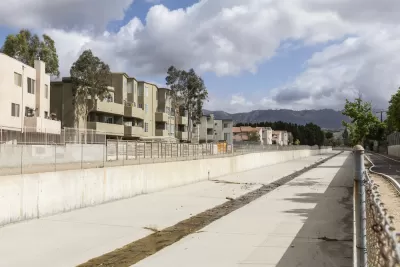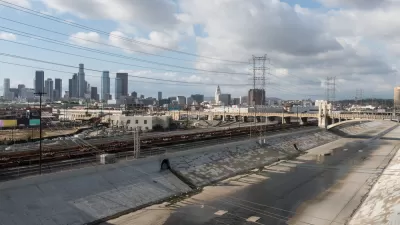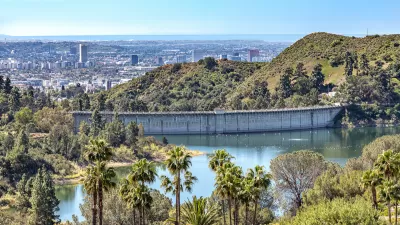In the past, stormwater management has been about flood control. The future of stormwater, however, is in capturing, treating, and recharging water supply, according to this article.

Chris Austin, otherwise known as the Maven of California water news, shares a presentation from Dr. Richard Luthy, a professor of civil and environmental engineering and the director of the National Science Foundation’s Engineering Research Center, describing the evolution of stormwater infrastructure.
According to Luthy, a shift away from stormwater management as flood control would bring multiple benefits. Not only would urban areas like Los Angeles gain critical water supply for a growing population, "it would provide other community benefits, like cleaning the beaches."
Luthy is building on existing plans by the city of Los Angeles to cut the amount of water supply it imports by half:
How is that achieved? One of the solutions is stormwater capture, and on this drawing, it says the stormwater would be 4% of the urban water supply, and in a moment I’ll show you that it could really be much more than that. It could be 3, 4, maybe even 5 times that if plans come into being in this century.”
In addition to an appeal to use bigger systems to achieve more ambitious goals, Luthy also shows how stormwater capture infrastructure can become open space and recreation facilities during dry seasons (e.g., hiking trails, basketball courts, and playfields). Finally, Luthy detailed the processes that would be necessary to treat stormwater runoff that could potentially be contaminated with pathogens, organics, and nitrates.
Renderings, schematics, and other infographics drawn directly from Luthy's presentation supplement the article.
FULL STORY: Stormwater capture, treatment and recharge for urban water supply

Study: Maui’s Plan to Convert Vacation Rentals to Long-Term Housing Could Cause Nearly $1 Billion Economic Loss
The plan would reduce visitor accommodation by 25,% resulting in 1,900 jobs lost.

North Texas Transit Leaders Tout Benefits of TOD for Growing Region
At a summit focused on transit-oriented development, policymakers discussed how North Texas’ expanded light rail system can serve as a tool for economic growth.

Using Old Oil and Gas Wells for Green Energy Storage
Penn State researchers have found that repurposing abandoned oil and gas wells for geothermal-assisted compressed-air energy storage can boost efficiency, reduce environmental risks, and support clean energy and job transitions.

Santa Barbara Could Build Housing on County Land
County supervisors moved forward a proposal to build workforce housing on two county-owned parcels.

San Mateo Formally Opposes Freeway Project
The city council will send a letter to Caltrans urging the agency to reconsider a plan to expand the 101 through the city of San Mateo.

A Bronx Community Fights to Have its Voice Heard
After organizing and giving input for decades, the community around the Kingsbridge Armory might actually see it redeveloped — and they want to continue to have a say in how it goes.
Urban Design for Planners 1: Software Tools
This six-course series explores essential urban design concepts using open source software and equips planners with the tools they need to participate fully in the urban design process.
Planning for Universal Design
Learn the tools for implementing Universal Design in planning regulations.
Ascent Environmental
Borough of Carlisle
Institute for Housing and Urban Development Studies (IHS)
City of Grandview
Harvard GSD Executive Education
Toledo-Lucas County Plan Commissions
Salt Lake City
NYU Wagner Graduate School of Public Service





























